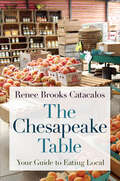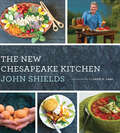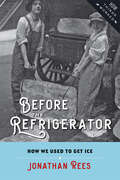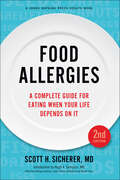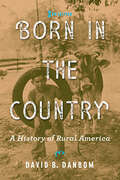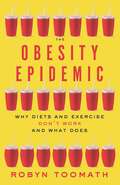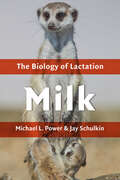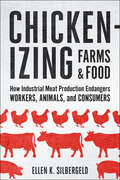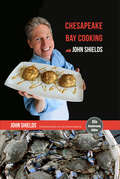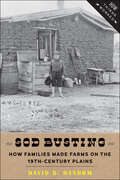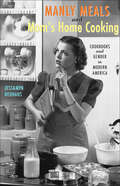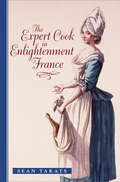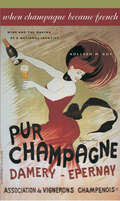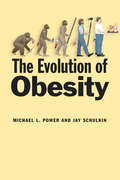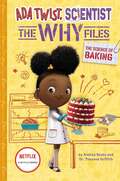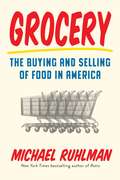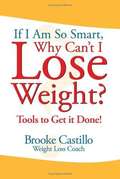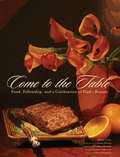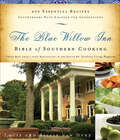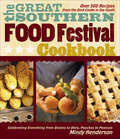- Table View
- List View
The Chesapeake Table: Your Guide to Eating Local
by Renee Brooks CatacalosDo you want to join a CSA, but don’t know where to start? Are you wondering what the difference between Certified Organic and Biodynamic produce is? This guide explains the many ways to participate in the local food movement in the Chesapeake.There was a time when most food was local, whether you lived on a farm or bought your food at a farmers market in the city. Exotic foods like olives, spices, and chocolate shipped in from other parts of the world were considered luxuries. Now, most food that Americans eat is shipped from somewhere else, and eating local is considered by some to be a luxury. Renee Brooks Catacalos is here to remind us that eating local is easier—and more rewarding—than we may think. There is an abundance of food all around us, found across the acres and acres of fields and pastures, orchards and forests, mile upon winding mile of rivers and streams, ocean coastline, and the amazing Chesapeake Bay.In The Chesapeake Table, Catacalos examines the powerful effect of eating local in Maryland, Virginia, and Washington, DC. Hooked on the local food movement from its early days, Catacalos opens the book by revisiting a personal challenge to only buy, prepare, and eat food grown within a 150-mile radius of her home near Washington, DC. From her in-depth, on-the-ground study of food systems in the region, Catacalos offers practical advice for adopting a locavore diet and getting involved in various entry points to food pathways, from shopping at your local farmers market to buying a community-supported agriculture share. She also includes recipes for those curious about how they can make their own more environmentally conscious food choices.Introducing readers to the vast edible resources of the Chesapeake region, Catacalos focuses on the challenges of environmental and economic sustainability, equity and diversity in the farming and food professions, and access and inclusion for local consumers of all income levels, ethnicities, and geographies. Touching on everything from farm-based breweries and distilleries to urban hoop house farms to grass-fed beef, The Chesapeake Table celebrates the people working hard to put great local food on our plates.
The Chesapeake Table: Your Guide to Eating Local
by Renee Brooks CatacalosFor consumers of all income levels, an extensive guide to participating in the local food movement in the Chesapeake region.There was a time when most food was local. Exotic foods like olives, spices, and chocolate shipped in from other parts of the world were considered luxuries. Now, most food that Americans eat is shipped from elsewhere, and many consider eating local to be a luxury. Renee Brooks Catacalos is here to remind us that eating local is easier?and more rewarding?than we may think. There is an abundance of food all around us, found all over the Chesapeake region.In The Chesapeake Table, Catacalos examines the powerful effect of eating local in Maryland, Virginia, and Washington, DC. Hooked on the local food movement from its early days, Catacalos opens the book by revisiting a personal challenge to buy, prepare, and eat only food grown within a 150-mile radius of her home near Washington, DC. From her in-depth study of food systems in the region, Catacalos offers practical advice for adopting a locavore diet and getting involved in various entry points to food pathways, from your local farmers market to community-supported agriculture (CSA). She also includes recipes that show how to make more environmentally conscious food choices.Introducing readers to the vast edible resources of the Chesapeake region, Catacalos focuses on the challenges of environmental and economic sustainability, equity and diversity in the farming and food professions, and access and inclusion for local consumers of all income levels, ethnicities, and geographies. Touching on everything from farm-based breweries and distilleries to urban hoop house farms to grass-fed beef, The Chesapeake Table celebrates the people working hard to put great local food on our plates.
The New Chesapeake Kitchen
by John ShieldsThe latest cookbook by the "Culinary Ambassador of the Chesapeake" encourages us to cook in a way that is not only healthy for us but also for the Bay.Captain John Smith, upon entering the Chesapeake, wrote in his diaries that the fish were so plentiful "we attempted to catch them with a frying pan." That method sums up classic Chesapeake cooking—fresh and simple. In The New Chesapeake Kitchen, celebrated Maryland chef John Shields takes the best of what grows, swims, or grazes in the Bay’s watershed and prepares it simply, letting the pure flavors shine through. Honoring the farmers, watermen, butchers, cheese makers, and foragers who make the food movement around the Chesapeake Bay watershed possible, along with the environmental and food organizations working to restore the Bay, the land, and food security, Shields promotes a healthy locavore diet and a holistic view of community foodways.In this scrumptious book, enhanced with beautiful full-color images by former Baltimore Sun Magazine photographer David W. Harp, Shields urges readers to choose local, seasonal ingredients. Presenting what he dubs "Bay- and body-friendly food," he advocates for a plant-forward and sustainable diet, one that considers how food consumption affects both your health and the environment. Shields presents creative and healthy options that nourish us while protecting the Bay, including one-pot recipes for meals like Fishing Creek Seafood Chili, Old Line Veggie Creole Oyster Stew, and Spring Pea Soup with Tarragon-Truffle Oil. To round it out, this holistic cookbook includes directions for canning, preserving, and fermenting.Shields offers many vegan- and vegetarian-friendly options, as well as innovative new takes on Chesapeake classics. You’ll find recipes for dozens of delicious dishes, from Aunt Bessie’s Crab Pudding and Hutzler’s Cheese Bread to "I Can’t Believe It’s Not Crab" Cakes, Blue Cat Seafood Hash, and an array of savory soups, braised meats, luscious desserts, and green breakfast smoothies—even recipes for a locavore cocktail party!
The New Chesapeake Kitchen
by John ShieldsFresh and simple recipes that celebrate the bounty of the Chesapeake Bay region—and protect its environment—from a renowned Maryland chef. Captain John Smith, upon entering the Chesapeake, wrote in his diaries that the fish were so plentiful “we attempted to catch them with a frying pan.” That method sums up classic Chesapeake cooking?fresh and simple. In The New Chesapeake Kitchen, celebrated chef John Shields takes the best of what grows, swims, or grazes in the Bay’s watershed and prepares it simply, letting the pure flavors shine through. Honoring the farmers, watermen, butchers, cheese makers, and foragers who make the food movement around the Chesapeake Bay watershed possible, along with the environmental and food organizations working to restore the Bay, the land, and food security, Shields promotes a healthy locavore diet and a holistic view of community foodways.This scrumptious book, with beautiful full-color images by former Baltimore Sun Magazine photographer David W. Harp, urges readers to choose local, seasonal ingredients. Presenting what he dubs “Bay- and body-friendly food,” Shields advocates for a plant-forward and sustainable diet. He presents creative and healthy choices, including one-pot recipes like Fishing Creek Seafood Chili, Old Line Veggie Creole Oyster Stew, and Spring Pea Soup with Tarragon-Truffle Oil. Also included are directions for canning, preserving, and fermenting.Shields offers many vegan- and vegetarian-friendly options, as well as innovative takes on Chesapeake classics. You’ll find dozens of delicious dishes, from Aunt Bessie’s Crab Pudding and Hutzler’s Cheese Bread to “I Can’t Believe It’s Not Crab” Cakes, Blue Cat Seafood Hash, and an array of savory soups, braised meats, luscious desserts, and green breakfast smoothies?even recipes for a locavore cocktail party!
Before the Refrigerator: How We Used to Get Ice (How Things Worked)
by Jonathan ReesHow increased access to ice—decades before refrigeration—transformed American life.During the late nineteenth and early twentieth centuries, Americans depended upon ice to stay cool and to keep their perishable foods fresh. Jonathan Rees tells the fascinating story of how people got ice before mechanical refrigeration came to the household. Drawing on newspapers, trade journals, and household advice books, Before the Refrigerator explains how Americans built a complex system to harvest, store, and transport ice to everyone who wanted it, even the very poor.Rees traces the evolution of the natural ice industry from its mechanization in the 1880s through its gradual collapse, which started after World War I. Meatpackers began experimenting with ice refrigeration to ship their products as early as the 1860s. Starting around 1890, large, bulky ice machines the size of small houses appeared on the scene, becoming an important source for the American ice supply. As ice machines shrunk, more people had access to better ice for a wide variety of purposes. By the early twentieth century, Rees writes, ice had become an essential tool for preserving perishable foods of all kinds, transforming what most people ate and drank every day. Reviewing all the inventions that made the ice industry possible and the way they worked together to prevent ice from melting, Rees demonstrates how technological systems can operate without a central controlling force. Before the Refrigerator is ideal for history of technology classes, food studies classes, or anyone interested in what daily life in the United States was like between 1880 and 1930.
Food Allergies: A Complete Guide for Eating When Your Life Depends on It (A Johns Hopkins Press Health Book)
by Scott H. SichererThe essential guide for anyone who suffers from food allergies.Posing the urgent questions that anyone with food allergies will think to ask—and then some—Food Allergies provides practical, sensitive, and scientific guidance on the topics that affect your life. Allergy expert Scott H. Sicherer addresses the full spectrum of food allergies, from mild to life threatening and from single foods to food families, clearing up misconceptions along the way. He explores how exposure to foods can bring about an allergic response, describes the symptoms of food allergy, and illuminates how food allergies develop.Organized in an accessible Q&A format and illustrated with case studies, the book thoroughly explains how to prevent exposure to a known allergen at home, at school, in restaurants, and elsewhere. Dr. Sicherer also gives valuable advice about what to do if exposure occurs, including how to handle an anaphylactic emergency. Finally, he describes tests for diagnosing food allergies and chronic health problems caused by food allergies, such as eczema, hives, and respiratory and gastrointestinal symptoms.In this thoroughly updated new edition, Dr. Sicherer• describes new approaches to prevent food allergies• presents cutting-edge theories on risk factors for developing food allergies• describes innovative allergy tests to improve diagnosis• explains how to administer emergency medications for severe reactions• focuses on new allergens of concern, such as pink peppercorns• analyzes studies suggesting that resolution of an allergy might be predictable• talks about the role of "healthy diet"• lists additional resources, including allergy-related apps• provides revised school food allergy guidelines• offers insights into food allergy bullying—and advice to reduce itDr. Sicherer also reviews food reactions that are not allergic (such as lactose intolerance and celiac disease), advises how to get adequate nutrition when you must avoid dietary staples, and discusses whether allergies ever go away (they do—and sometimes they return).
Born in the Country: A History of Rural America (Revisiting Rural America)
by David B. DanbomUpdated edition: “A balanced economic, social, political, and technological history of rural America . . . A splendid book, rich with detail.” —Agricultural History ReviewThrough most of its history, America has been a rural nation, largely made up of farmers. David B. Danbom’s Born in the Country was the first—and is still the only—general history of rural America. Ranging from pre-Columbian times to the enormous changes of the twentieth century, the book masterfully integrates agricultural, technological, and economic themes with new questions about the American experience. Danbom employs the stories of particular farm families to illustrate the experiences of rural people. This substantially revised and updated third edition:• expands and deepens its coverage of the late twentieth and early twenty-first centuries• focuses on the changes in agriculture and rural life in the progressive and New Deal eras as well as the massive shifts that have taken place since 1945• adds new information about African American and Native American agricultural experiences• discusses the decline of agriculture as a productive enterprise and its impact on farm families and communities• explores rural culture, gender issues, agriculture, and the environment• traces the relationship among farmers, agribusiness, and consumersIn a new and provocative concluding chapter, Danbom reflects on increasing consumer disenchantment with and resistance to modern agriculture as well as the transformation of rural America into a place where farmers are a shrinking minority. Ultimately, he asks whether a distinctive style of rural life exists any longer in the United States.“A delightful story tracing the social history of U.S. farmers. The book details the attitudes and social life of farm people?how they looked at themselves and how the rest of society saw them.” —Forum
The Obesity Epidemic: Why Diets and Exercise Don't Work—and What Does
by Robyn ToomathWhy modern life makes it almost impossible for people to lose weight and keep it off.In a world where charlatans promise to fix the alarming obesity epidemic with a silver-bullet diet or trendy new exercise program, Robyn Toomath, a physician and realist, steps out of the fray to deliver some tough news: it’s really hard to lose weight. Dispelling common myths and telling provocative truths about weight gain—and loss—The Obesity Epidemic is an engaging investigation into the complicated factors that lead to obesity. While genes certainly play a part, Toomath argues, more people are fat than ever before because most of us consume significantly more calories than we did 30 years ago. But why? The answer, she asserts, is the commodification of food created by junk food advertising coupled with urbanization, globalization, and trade agreements. And while government, advertisers, gyms, and the weight loss industry keep pushing solutions that science shows do not work—from extreme exercise regimens and fad dieting to prohibitively expensive surgeries, pills, and misguided education campaigns—Toomath outlines what just might make a difference in terms of helping people truly control their weight.Drawing on the latest research and her twenty years of working with overweight patients, Dr. Toomath argues that even strongly determined people who are offered appealing incentives typically cannot lose weight permanently. Instead of demonizing people by treating weight as an issue of personal or even moral responsibility, Dr. Toomath makes it clear that nothing will change until we make it easy, not all but impossible, for people to eat healthily. Raising important questions about obesity, Toomath sidesteps the standard sound bites and puts an end to the myth of personal responsibility for body size by focusing on the environment all around us.
Milk: The Biology of Lactation
by Jay Schulkin Michael L. PowerEverything you ever wanted to know about the substance that binds all mammals together.After drawing its first breath, every newborn mammal turns his or her complete attention to obtaining milk. This primal act was once thought to stem from a basic fact: milk provides the initial source of calories and nutrients for all mammalian young. But it turns out that milk is a much more complicated biochemical cocktail and provides benefits beyond nutrition. In this fascinating book, biologists Michael L. Power and Jay Schulkin reveal this liquid’s evolutionary history and show how its ingredients have changed over many millions of years to become a potent elixir. Power and Schulkin walk readers through the early origins of the mammary gland and describe the incredible diversification of milk among the various mammalian lineages. After revealing the roots of lactation, the authors describe the substances that naturally occur in milk and discuss their biological functions. They reveal that mothers pass along numerous biochemical signals to their babies through milk. The authors explain how milk boosts an infant’s immune system, affects an infant’s metabolism and physiology, and helps inoculate and feed the baby’s gut microbiome. Throughout the book, the authors weave in stories from studies of other species, explaining how comparative research sheds light on human lactation. The authors then turn their attention to the fascinating topic of cross-species milk consumption—something only practiced by certain humans who evolved an ability to retain lactase synthesis into adulthood. The first book to discuss milk from a comparative and evolutionary perspective, Power and Schulkin’s masterpiece reveals the rich biological story of the common thread that connects all mammals.
Chickenizing Farms and Food: How Industrial Meat Production Endangers Workers, Animals, and Consumers
by Ellen K. SilbergeldA frightening look at the meat industry’s cost to public health, worker safety, and the future of medicine—as well as the potential for agricultural reform.Over the past century, new farming methods, feed additives, and social and economic structures have radically transformed agriculture around the globe, often at the expense of human health. In Chickenizing Farms and Food, Ellen K. Silbergeld reveals the unsafe world of chickenization—big agriculture’s top-down, contract-based factory farming system—and its negative consequences for workers, consumers, and the environment. Drawing on her deep knowledge of and experience in environmental engineering and toxicology, Silbergeld examines the complex history of the modern industrial food animal production industry and describes the widespread effects of Arthur Perdue’s remarkable agricultural innovations, which were so important that the US Department of Agriculture uses the term chickenization to cover the transformation of all farm animal production. Silbergeld tells the real story of how antibiotics were first introduced into animal feeds in the 1940s, which has led to the emergence of multi-drug-resistant pathogens, such as MRSA. Along the way, she talks with poultry growers, farmers, and slaughterhouse workers on the front lines of exposure, moving from the Chesapeake Bay peninsula that gave birth to the modern livestock and poultry industry to North Carolina, Brazil, and China.Arguing that the agricultural industry is in desperate need of reform, the book searches through the fog of illusion that obscures most of what has happened to agriculture in the twentieth century and untangles the history of how laws, regulations, and policies have stripped government agencies of the power to protect workers and consumers alike from occupational and food-borne hazards. Chickenizing Farms and Food also explores the limits of some popular alternatives to industrial farming, including organic production, nonmeat diets, locavorism, and small-scale agriculture. Silbergeld’s provocative but pragmatic call to action is tempered by real challenges: how can we ensure a safe and accessible food system that can feed everyone, including consumers in developing countries with new tastes for western diets, without hurting workers, sickening consumers, and undermining some of our most powerful medicines?
Chesapeake Bay Cooking with John Shields
by John ShieldsThis twenty-fifth anniversary edition of John Shields’s classic cookbook includes additional recipes and a new chapter on Chesapeake libations.Twenty-five years ago, Chesapeake Bay Cooking with John Shields introduced the world to the regional cuisine of the Mid-Atlantic. Nominated for a James Beard Award, the book was praised for its inspiring heritage recipes and its then-revolutionary emphasis on cooking with local and seasonal ingredients. Part history lesson, part travelogue, the book captured the unique character of the Chesapeake region and its people.In this anniversary edition, John Shields combines popular classic dishes with a host of unpublished recipes from his personal archives. Readers will learn how to prepare over 200 recipes from the Mid-Atlantic region, including panfried rockfish, roast mallard, beaten biscuits, oyster fritters, and Lady Baltimore cake. Best of all, they’ll learn everything they need to know about crabs—the undisputed star of Chesapeake cuisine—featured here in mouthwatering recipes for seven different kinds of crab cakes.Extensively updated, this edition includes a new chapter on Chesapeake libations, which features Shields’s closely held recipe for his notorious Dirty Gertie, an authentic Chesapeake-style Bloody Mary.
Chesapeake Bay Cooking with John Shields
by John. ShieldsDiscover the cuisine and the character of the Chesapeake Bay with the twenty-fifth-anniversary edition of this collection of over 200 regional, seasonal recipes.Twenty-five years ago, Chesapeake Bay Cooking with John Shields introduced the world to the regional cuisine of the Mid-Atlantic. Nominated for a James Beard Award, the book was praised for its inspiring heritage recipes and its then-revolutionary emphasis on cooking with local and seasonal ingredients. Part history lesson, part travelogue, the book captured the unique character of the Chesapeake region and its people.In this anniversary edition, John Shields combines popular classic dishes with a host of unpublished recipes from his personal archives. Readers will learn how to prepare over 200 recipes from the Mid-Atlantic region, including panfried rockfish, roast mallard, beaten biscuits, oyster fritters, and Lady Baltimore cake. Best of all, they’ll learn everything they need to know about crabs?the undisputed star of Chesapeake cuisine?featured here in mouthwatering recipes for seven different kinds of crab cakes.Extensively updated, this edition includes a new chapter on Chesapeake libations, which features Shields’s closely held recipe for his notorious Dirty Gertie, an authentic Chesapeake-style Bloody Mary.“Long before it was trendy to serve sustainable, local, and organic food, Maryland native Shields was doing it at Gertrude’s, a modest modern restaurant tucked inside the Baltimore Museum of Art. This fall he reissued his prescient chronicle of the waterman’s way of life and traditional cooking on the mid-Atlantic coast. It includes how to “pick” steamed crabs (seasoned with Old Bay, natch), prepare country sides like Green Beans With Country Ham and Sautéed Peanuts, and make the quirky relish known as chow-chow.” —April Fulton, National Geographic’sfood blog, The Plate“John knows and loves the Chesapeake as only a native can. One of the best regional American cookbooks you’ll ever find.” —Gourmet“For those who are not familiar with the “good old down home” taste of cooking by a native of the Chesapeake Bay region, John Shields brings you an experience you'll never forget. For those of us who are fortunate enough to be a part of this region, Mr. Shields reminds us of the experience we’ll always remember.” —The Honorable William Donald Schaefer, former governor of Maryland
Sod Busting: How Families Made Farms on the 19th-Century Plains (How Things Worked)
by David B. Danbom“An excellent introduction to the challenges and opportunities of agricultural life in a difficult region for farming . . . elegantly written.” —Jeff Bremer, The Annals of IowaPrairie busting is central to the lore of westward expansion, but how was it actually accomplished with little more than animal and human power? In Sod Busting, David B. Danbom challenges students to think about the many practicalities of surviving on the Great Plains in the late nineteenth century by providing a detailed account of how settlers acquired land and made homes, farms, and communities. He examines the physical and climatic obstacles of the plains—perhaps America’s most inhospitable frontier—and shows how settlers sheltered themselves, gained access to fuel and water, and broke the land for agriculture.Treating the Great Plains as a post-industrial frontier, Danbom delves into the economic motivations of settlers, how they got the capital they needed to succeed, and how they used the labor of the entire family to survive until farms returned profits. He examines closely the business decisions that determined the success or failure of these farmers in a boom-and-bust economy; details the creation of churches, schools, and service centers that enriched the social and material lives of the settlers; and shows how the support of government, railroads, and other businesses contributed to the success of plains settlement.Based on contemporary accounts, settlers’ reminiscences, and the work of other historians, Sod Busting dives deeply into the practical realities of how things worked to make vivid one of the quintessentially American experiences, breaking new land.“A cogent and engaging portrait of the real lives of those who settled the Great Plains.” —Nebraska History
Manly Meals and Mom's Home Cooking: Cookbooks and Gender in Modern America
by Jessamyn NeuhausFrom the first edition of The Fannie Farmer Cookbook to the latest works by today's celebrity chefs, cookbooks reflect more than just passing culinary fads. As historical artifacts, they offer a unique perspective on the cultures that produced them. In Manly Meals and Mom's Home Cooking, Jessamyn Neuhaus offers a perceptive and piquant analysis of the tone and content of American cookbooks published between the 1790s and the 1960s, adroitly uncovering the cultural assumptions and anxieties—particularly about women and domesticity—they contain.Neuhaus's in-depth survey of these cookbooks questions the supposedly straightforward lessons about food preparation they imparted. While she finds that cookbooks aimed to make readers—mainly white, middle-class women—into effective, modern-age homemakers who saw joy, not drudgery, in their domestic tasks, she notes that the phenomenal popularity of Peg Bracken's 1960 cookbook, The I Hate to Cook Book, attests to the limitations of this kind of indoctrination. At the same time, she explores the proliferation of bachelor cookbooks aimed at "the man in the kitchen" and the biases they display about male and female abilities, tastes, and responsibilities.Neuhaus also addresses the impact of World War II rationing on homefront cuisine; the introduction of new culinary technologies, gourmet sensibilities, and ethnic foods into American kitchens; and developments in the cookbook industry since the 1960s. More than a history of the cookbook, Manly Meals and Mom's Home Cooking provides an absorbing and enlightening account of gender and food in modern America.
Manly Meals and Mom's Home Cooking: Cookbooks and Gender in Modern America
by Jessamyn NeuhausA study of what American cookbooks from the 1790s to the 1960s can show us about gender roles, food, and culture of their time.From the first edition of The Fannie Farmer Cookbook to the latest works by today’s celebrity chefs, cookbooks reflect more than just passing culinary fads. As historical artifacts, they offer a unique perspective on the cultures that produced them. In Manly Meals and Mom’s Home Cooking, Jessamyn Neuhaus offers a perceptive and piquant analysis of the tone and content of American cookbooks published between the 1790s and the 1960s, adroitly uncovering the cultural assumptions and anxieties—particularly about women and domesticity—they contain.Neuhaus’s in-depth survey of these cookbooks questions the supposedly straightforward lessons about food preparation they imparted. While she finds that cookbooks aimed to make readers—mainly white, middle-class women—into effective, modern-age homemakers who saw joy, not drudgery, in their domestic tasks, she notes that the phenomenal popularity of Peg Bracken’s 1960 cookbook, The I Hate to Cook Book, attests to the limitations of this kind of indoctrination. At the same time, she explores the proliferation of bachelor cookbooks aimed at “the man in the kitchen” and the biases they display about male and female abilities, tastes, and responsibilities.Neuhaus also addresses the impact of World War II rationing on homefront cuisine; the introduction of new culinary technologies, gourmet sensibilities, and ethnic foods into American kitchens; and developments in the cookbook industry since the 1960s. More than a history of the cookbook, Manly Meals and Mom’s Home Cooking provides an absorbing and enlightening account of gender and food in modern America.“An engaging analysis . . . Neuhaus provides a rich and well-researched cultural history of American gender roles through her clever use of cookbooks.” —Sarah Eppler Janda, History: Reviews of New Books“With sound scholarship and a focus on prescriptive food literature, Manly Meals makes an original and useful contribution to our understanding of how gender roles are institutionalized and perpetuated.” —Warren Belasco, senior editor of The Oxford Encyclopedia of American Food and Drink“An excellent addition to the history of women’s roles in America, as well as to the history of cookbooks.” —Choice
The Expert Cook in Enlightenment France (The Johns Hopkins University Studies in Historical and Political Science #129)
by Sean TakatsIn the eighteenth-century French household, the servant cook held a special place of importance, providing daily meals and managing the kitchen and its finances. In this scrupulously researched and witty history, Sean Takats examines the lives of these cooks as they sought to improve their position in society and reinvent themselves as expert, skilled professionals.Much has been written about the cuisine of the period, but Takats takes readers down into the kitchen and introduces them to the men and women behind the food. It is only in that way, Takats argues, that we can fully recover the scientific and cultural significance of the meals they created, and, more important, the contributions of ordinary workers to eighteenth-century intellectual life. He shows how cooks, along with decorators, architects, and fashion merchants, drove France’s consumer revolution, and how cooks' knowledge about a healthy diet and the medicinal properties of food advanced their professional status by capitalizing on the Enlightenment’s new concern for bodily and material happiness. The Expert Cook in Enlightenment France explores a unique intersection of cultural history, labor history, and the history of science and medicine. Relying on an unprecedented range of sources, from printed cookbooks and medical texts to building plans and commercial advertisements, Takats reconstructs the evolving role of the cook in Enlightenment France. Academics and students alike will enjoy this fascinating study of the invention of the professional chef, of how ordinary workers influenced emerging trends of scientific knowledge, culture-creation, and taste in eighteenth-century France.
When Champagne Became French: Wine and the Making of a National Identity (The Johns Hopkins University Studies in Historical and Political Science #121)
by Kolleen M. GuyWinner of the 2002 Manuscript Award from Phi Alpha ThetaWinner of the Gourmand World Cookbook Awards for English Wine, Best Wine History Book, and Best Book on French WineWinner of the Clicquot Wine Book of the Year CompetitionWinner of the Outstanding Manuscript Award from Phi Alpha Theta, this work explains how nationhood emerges by viewing countries as cultural artifacts, a product of "invented traditions." In the case of France, scholars sharply disagree, not only over the nature of French national identity but also over the extent to which diverse and sometimes hostile provincial communities became integrated into the nation. In When Champagne Became French: Wine and the Making of a National Identity, Kolleen M. Guy offers a new perspective on this debate by looking at one of the central elements in French national culture—luxury wine—and the rural communities that profited from its production.Focusing on the development of the champagne industry between 1820 and 1920, Guy explores the role of private interests in the creation of national culture and in the nation-building process. Drawing on concepts from social and cultural history, she shows how champagne helped fuel the revolution in consumption as social groups searched for new ways to develop cohesion and to establish status. By the end of the nineteenth century, Guy concludes, the champagne-producing provinces in the department of Marne had developed a rhetoric of French identity that promoted its own marketing success as national. This ability to mask local interests as national concerns convinced government officials of the need, at both national and international levels, to protect champagne as a French patrimony.
The Evolution of Obesity
by Jay Schulkin Michael L. PowerIn this sweeping exploration of the relatively recent obesity epidemic, Michael L. Power and Jay Schulkin probe evolutionary biology, history, physiology, and medical science to uncover the causes of our growing girth. The unexpected answer? Our own evolutionary success.For most of the past few million years, our evolutionary ancestors' survival depended on being able to consume as much as possible when food was available and to store the excess energy for periods when it was scarce. In the developed world today, high-calorie foods are readily obtainable, yet the propensity to store fat is part of our species' heritage, leaving an increasing number of the world's people vulnerable to obesity. In an environment of abundant food, we are anatomically, physiologically, metabolically, and behaviorally programmed in a way that makes it difficult for us to avoid gaining weight.Power and Schulkin’s engagingly argued book draws on popular examples and sound science to explain our expanding waistlines and to discuss the consequences of being overweight for different demographic groups. They review the various studies of human and animal fat use and storage, including those that examine fat deposition and metabolism in men and women; chronicle cultural differences in food procurement, preparation, and consumption; and consider the influence of sedentary occupations and lifestyles.A compelling and comprehensive examination of the causes and consequences of the obesity epidemic, The Evolution of Obesity offers fascinating insights into the question, Why are we getting fatter?
The Science Of Baking: (Ada Twist, Scientist: The Why Files #3) (Questioneers)
by Andrea Beaty Theanne GriffithFrom the New York Times bestselling creator of the Questioneers, Andrea Beaty, and author Theanne Griffithcomes The Science of Baking (Ada Twist, Scientist: The Why Files), a nonfiction early-reader book based on the Netflix series! <P><P> How does a cake bake? What’s the difference between baking soda and baking powder? And why is it so important to measure the different ingredients in a recipe? Ada Twist, Scientist: The Why Files is the perfect nonfiction resource for all these questions and more. Based on the bestselling series and the Netflix show, this nonfiction series is perfect for the youngest scientists of tomorrow as they learn along with Ada. Designed in a scrapbook format, these books combine art from the show, illustrations, and photography to bring simple science concepts to life.
F*ck It, I'll Start Tomorrow: A True Story
by Action Bronson Bonnie StephensFrom the New York Times bestselling author, chef-turned-rapper, and host of Viceland’s F*ck, That’s Delicious and The Untitled Action Bronson Show, F*ck It, I’ll Start Tomorrow is a brutally honest chronicle about struggles with weight, food addiction, and the journey to self-acceptance. <p><p> In his signature voice, Action Bronson shares all that he’s learned in the past decade to help you help yourself. This isn’t a road map to attaining a so-called perfect body. Instead, Bronson will share his journey to find confidence, keep the negative vibes at bay, stay sane, chill out, and not look in the mirror hoping to see anyone but yourself. F*ck It, I’ll Start Tomorrow is not about losing weight—it’s about being and feeling excellent regardless of your size or shape. It’s about living f*cking healthy, period.
Grocery: The Buying and Selling of Food in America
by Michael RuhlmanIn a culture obsessed with food—how it looks, what it tastes like, where it comes from, what is good for us—there are often more questions than answers. Ruhlman proposes that the best practices for consuming wisely could be hiding in plain sight—in the aisles of your local supermarket. Using the human story of the family-run Midwestern chain Heinen's as an anchor to this journalistic narrative, he dives into the mysterious world of supermarkets and the ways in which we produce, consume, and distribute food. Grocery examines how rapidly supermarkets—and our food and culture—have changed since the days of your friendly neighborhood grocer. But rather than waxing nostalgic for the age of mom-and-pop shops, Ruhlman seeks to understand how our food needs have shifted since the mid-twentieth century, and how these needs mirror our cultural ones. A mix of reportage and rant, personal history and social commentary, Grocery is a landmark book from one of our most insightful food writers.
If I Am So Smart, Why Can't I Lose Weight? Tools to Get It Done
by Brooke CastilloFrom the book: If you want to win at weight loss, you need a great coach! In warm, inspiring prose, weight loss mentor Brooke Castillo will empower you, teaching you the skills you need to get the body you want, and giving you the tools you need for continuing on your own. Based on the same unique process she uses with her private clients, Brooke Castillo teaches you to find, challenge, and change the emotional issues that keep you from achieving your ideal weight. You'll learn why you shouldn't exercise for results and how to pinpoint what's keeping you from losing weight. And you'll discover the best and most effective ways to really feel your feelings, which can help you start to notice other things beside your weight-like desires, dreams and goals. Humorous and insightful, If I Am So Smart, Why Can't I Lose Weight? Tools to Get it Done gives you the map you need to get your life-and your weight-going in the right direction.
Come to the Table: Food, Fellowship, and a Celebration of God's Bounty (A\souledout Sisters Novel Ser.)
by Benita LongA cookbook with a focus on entertaining family and friends, featuring photographs of table settings and meals, as well inspirational quotes and Scriptures. God intends for us, as sacred life travelers, to celebrate and enjoy His bounty. Every man should eat and drink and enjoy the good of all his labor for it is the gift of God.This celebration of life was intended by God to be a way of life now and as preparation for a future event in which as followers of Christ, all are invited to participate. God intends for us to enjoy his blessings in abundance.Come to the Table is a threefold feast. For the mind, there are thought-provoking quotations from great poets and thinkers. For the spirit, stunning photographs and inspirational Scriptures transport you to another realm. For the body, there are hearty and delectable recipes.Inside the collection, you’ll find soothing dishes for the soul including . . . Parmesan Grits Casserole,Grilled Lemon Chicken,Cheddar Squash Strata,Lamb Kabobs and much more! Throughout Come to the Table, very few people appear. This is our personal way of inviting you to claim each setting as your own.“That the mountains shall drip with new wine, the hills shall flow with milk, and all the brooks of Judah shall be flooded with water” [Joel 3:18].
The Blue Willow Inn Bible of Southern Cooking: 450 Essential Recipes Southerners Have Enjoyed for Generations
by Louis Van Dyke Billie Van Dyke"It's Ecstasy come Dixie." —Southern LivingThe Most Extensive Collection of Southern Recipes Ever in One BookVoted Southern Living magazine's 1996 Reader's Choice Award for best small-town restaurant in the Southandthe"Best in the South" for six years straight, the Blue Willow Inn is the quintessential eatery for fans of traditional Southern cuisine.Now, you can recreate the Blue Willow Inn experience in your own kitchen with over 600 classic Southern recipes, including:Blue Willow Inn's Famous Fried Green Tomatoes (page 170)Chicken and Dumplings (page 90)Virginia's Vidalia Onion Dip (page 58)Kudzu Blossom Jelly (page 83)Mom's Sweet Potato Casserole (page 194)Alabama "Blue Ribbon" Banana Pudding (page 342)Southern Fried Chicken (page 247)Thanks to proprietor Billie Van Dyke, as well as cooks from all over the South, you can now experience the culinary wonders of the Blue Willow Inn's delectable taste in your very own kitchen. Recipes passed down from generation to generation, adapted and enhanced through the years, have been collected into the most comprehensive collection of Southern recipes ever published.
The Great Southern Food Festival Cookbook: Celebrating Everything from Onions to Okra, Peaches to Peanuts
by Mindy HendersonA celebration of Southern food and fun with over three hundred recipes and information on seventy-five great events!A food festival is a wonderfully American event that happens in small towns and large cities all over the South, celebrating everything from onions to peanuts, chocolate to chowder. This collection is both cookbook and travel guide, with delicious recipes and festival information on events from Virginia to Texas. Southern food and Southern parties—or rather Southern parties about Southern food—are the very best kind. Featured festivals include:Chicken and Egg Festival—Moulton, AlabamaWest Virginia Strawberry Festival—Buckhannon, West VirginiaBradley County Pink Tomato Festival—Warren, ArkansasShrimp and Grits: The Wild Georgia Shrimp Festival, Jekyll Island, GeorgiaSuffolk Peanut Festival—Suffolk, VirginiaCornbread Festival—South Pittsburgh, TNHouston Hot Sauce Festival—Houston, Texas
